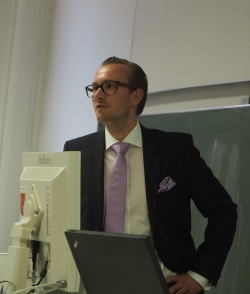
Andreas Habertheuer at the Going USA lecture © ACW
My name is Andreas Habertheuer and I am currently a PhD student in the Vascular Biology program, Department of Cardiac Surgery, Medical University of Vienna. I was a member of the Internal Medicine Residency Training Program in Philadelphia in the summer of 2012 and that’s where I started my USMLE journey.
The United States Medical Licensing Examination (USMLE)
The USMLE is a three-step examination for medical licensure in the United States and is sponsored by the Federation of State Medical Boards (FSMB) and by the National Board of Medical Examiners (NBME). The USMLE assesses a physician’s ability to apply knowledge, concepts and principles and to demonstrate fundamental patient-centered skills. Every step assesses different subjects and fields of medicine: USMLE Step 1 has special emphasis on basic science; USMLE Step 2CS emphasizes on clinical skills and USMLE Step 2 CK on clinical knowledge. USMLE Step 3 tests clinical principals essential for the unsupervised clinical practice and is taken by most physicians during a residency program in the United States.
The Residency Program in Philadelphia
The Internal Medicine Residency Training Program is already a fairly good preparation for Step 2CS as you have the chance to see, evaluate and follow patients yourself every day and I decided to take this challenge after about 2 months in Philadelphia without much preparation.
The only textbook I used by this time was “First Aid for USMLE Step 2CS” and the exam is basically structured like a normal clinical visit. However, with significant time constraints and you are in a rush the entire day. You see 12 “standardized” patients covering the most common and most important clinical situations, ranging from the newborn with a cough to the elderly disabled patient and you are required to gather a structured history, perform a physical examination, communicate your findings and propose a differential diagnosis as well as next steps of action.
Sooner or later during each clinical encounter every patient comes up with either a “tricky” question requiring you to be familiar with the US health care system or a difficult clinical situation, which you are required to handle respectfully, empathetically and in a proper manner. In terms of time constraints, every clinical encounter is stopped after 15min and you are given another 10 minutes to write an entire patient note in US style.
Step 2 CS uses standardized patients to test medical students and graduates on their ability to gather information from patients, perform physical examinations, and communicate their findings to patients and colleague
Upon returning to Vienna I started both my PhD program and preparation for USMLE Step 1, which unfortunately was interrupted on a regular basis by my PhD curriculum. Subjects being tested include:
- Behavioral science
- Biochemistry
- Embryology
- Microbiology
- Immunology
- Pathology
- Pharmacology
- Cardiovascular
- Endocrinology
- Gastrointestinal
- Hematology and Oncology
- Musculoskeletal and Connective Tissue
- Neurology
- Psychiatry
- Renal
- Reproductive
- Respiratory
Preparation for Step 1 is extensive and challenging. I focused on “First Aid for USMLE Step 1”, Kaplan Lecture Notes (only selected topics which were not sufficiently explained in First Aid) and Pathoma Pathology plus Pathoma Pathology vidoes covering all concepts of pathology. I did biostatistics and Hem/Onc from Goljan Pathology. If I would take the exam again, I would watch the Kaplan videos as well, but retrospectively, I had not enough time to do so. Additionally I did the USMLE World Q-bank as well as the Kaplan Q-bank covering about 5,000 questions and spent the last week of studying before taking the exam doing NBME self-assessment tests.
Step 1 lasts an entire day with 322 multiple-choice questions and seven 60-minute blocks. I studied for about 10 months and finally took the exam in December 2013 in Munich. On the test day, examinees have a minimum of 45 minutes of break time and a 15- minute optional tutorial. The amount of time available for breaks may be increased by finishing a block of test items or the optional tutorial before the allotted time expires.
Retrospectively, it was a hard and exhausting day and the most important thing is trying to stay concentrated and focused for a very long period of time. Question-stems tend to be long and may offer much more than the 5 answers we are familiar with in our curriculum (SIP) and I found questions with 20 possible answers and more.
Currently I am preparing for USMLE Step 2 CK and I will keep you posted!
Best of luck…
Andreas Habertheuer
(Vienna, 2014)
If you would like to know more about Mr. Habertheuer’s USMLE experience or follow his career, send us an email to office@goinginternational.org and we will forward it to him.
You can download this report as a PDF file here.
Tip: More up to date educational events dealing with healthcare can be found online on the Education Database »medicine & health«.
